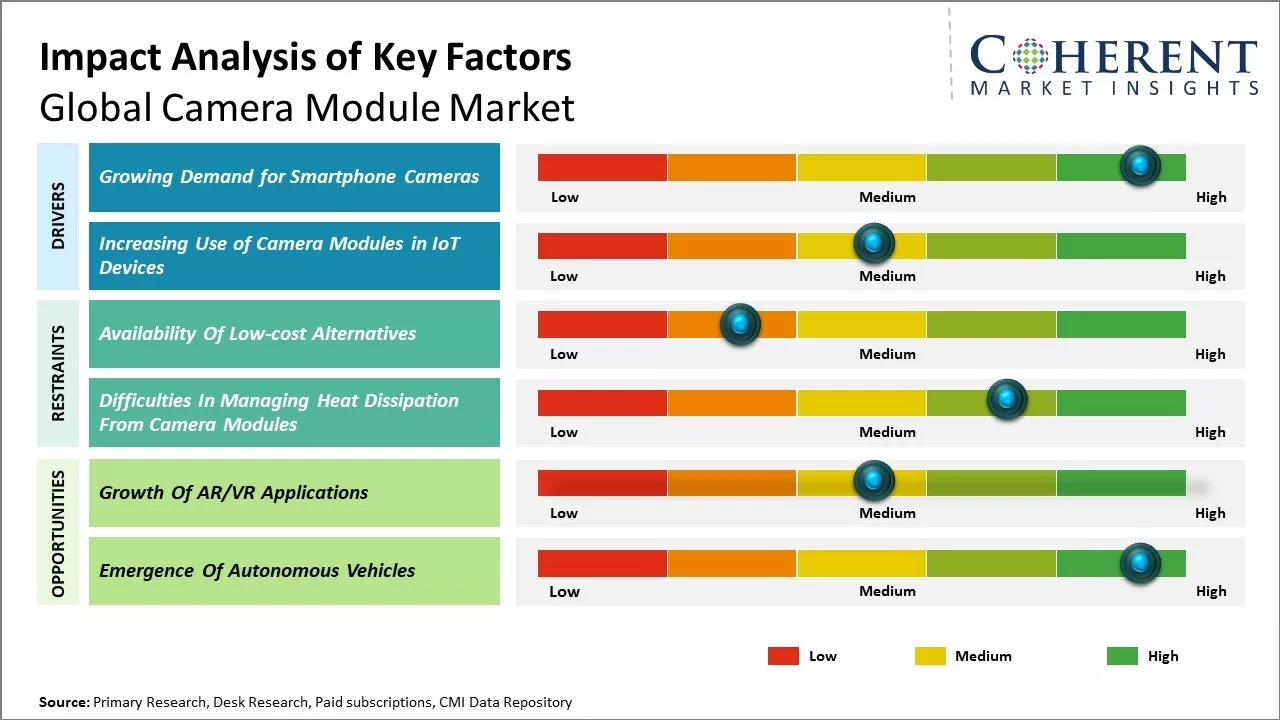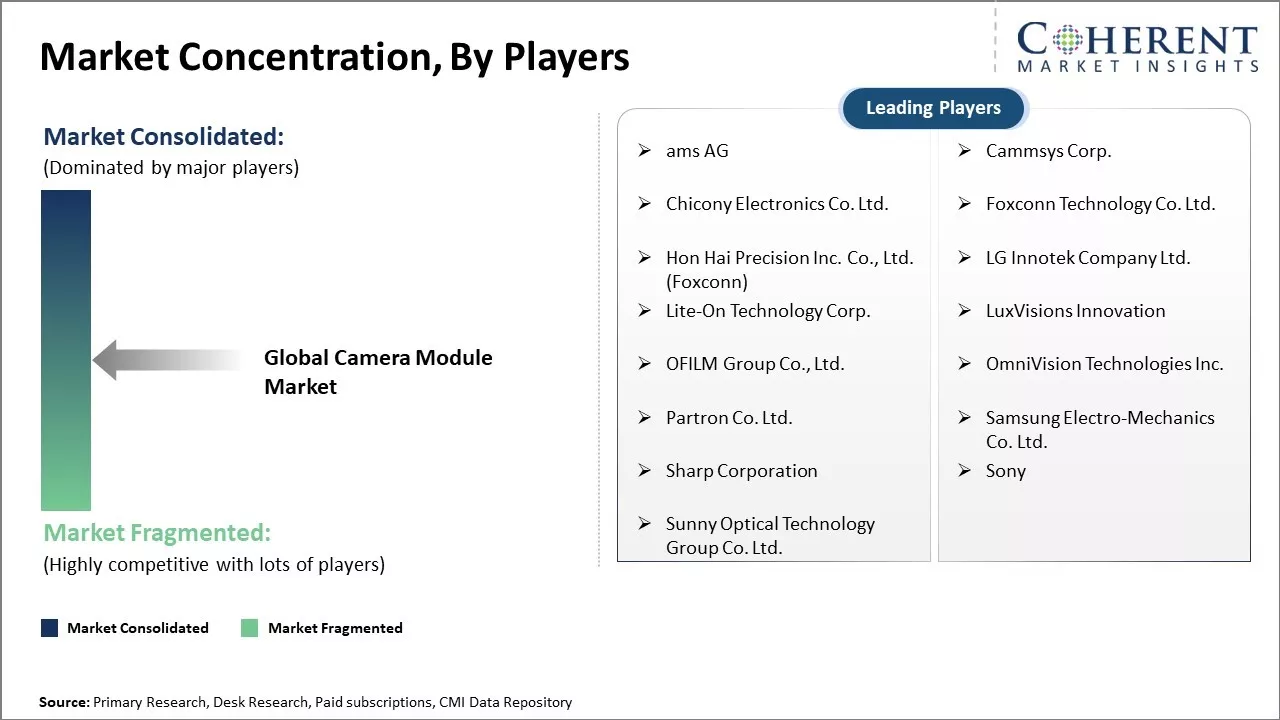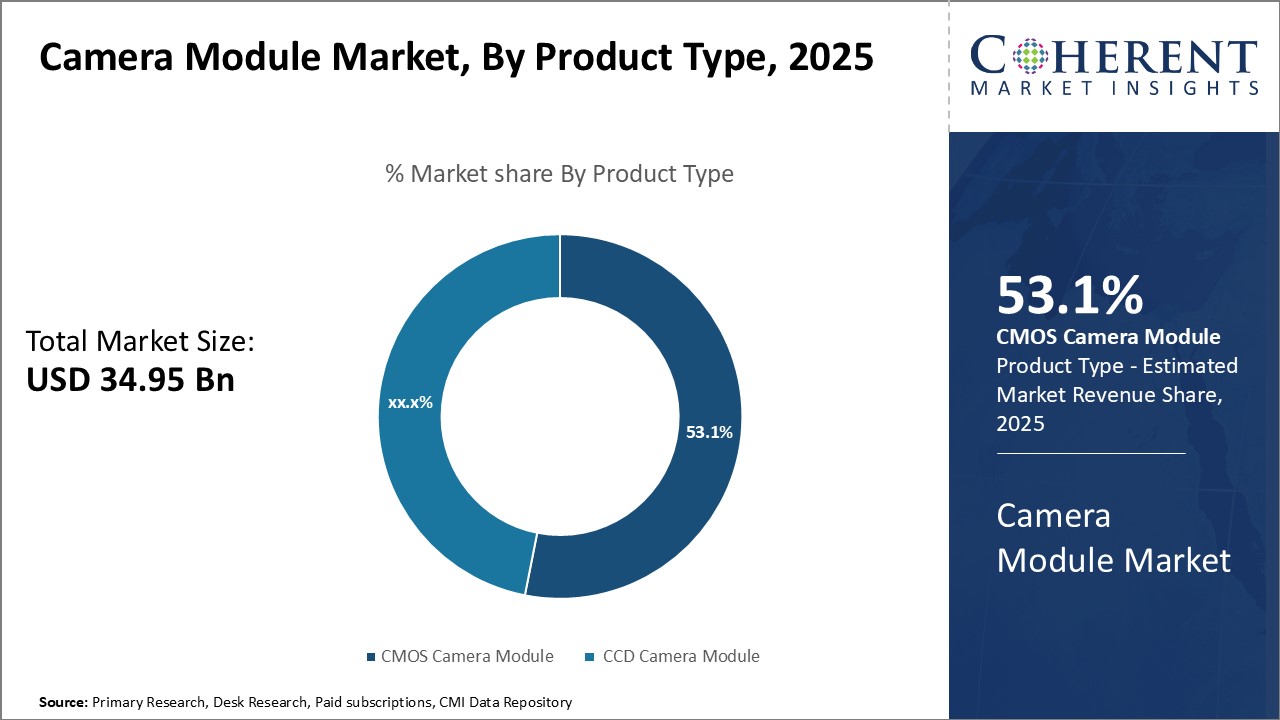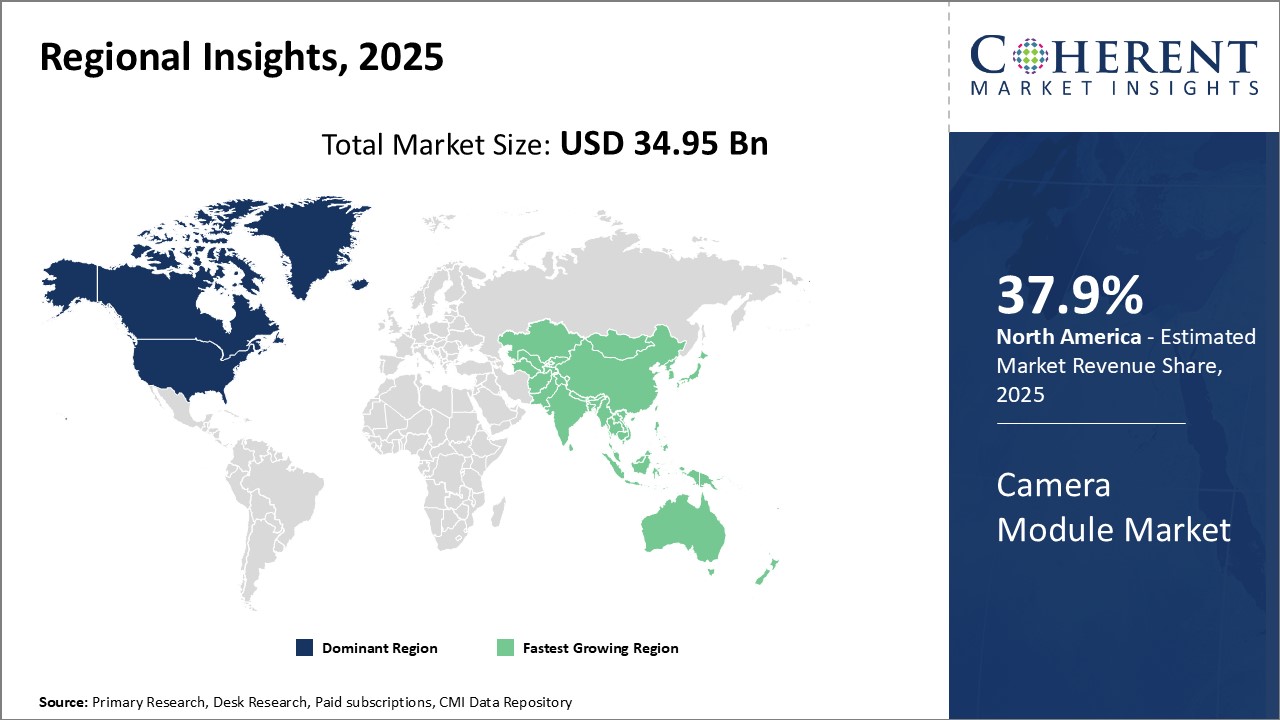
The global camera module market is estimated to be valued at US$ 34.95 Bn in 2025 and is expected to reach US$ 77.31 Bn by 2032, exhibiting a compound annual growth rate (CAGR) of 12.0% from 2025 to 2032.

Discover market dynamics shaping the industry: Download Free Sample
The camera module market is expected grow steadily during the forecast period. The growth in the demand for smartphones with multiple rear and front cameras has boosted the demand for camera modules. In addition, the rising adoption of driver assisted technologies and autonomous vehicles has increased the use of camera modules for Advanced Driver Assistance Systems (ADAS) features. Emerging applications of cameras in entertainment electronics, such as Virtual Reality Headset and smart wearables, is another factor driving the camera module market. However, high costs of manufacturing camera modules with advanced features can restraint the market growth to some extent.
Growing Demand for Smartphone Cameras
The use of camera modules in smartphones has seen tremendous growth over the past decade. As smartphones have become increasingly powerful and feature-rich, camera technology has become a key selling point for original equipment manufacturer (OEMs) looking to stand out in a crowded market. Consumers now expect high megapixel counts and advanced photo capabilities similar to dedicated cameras. Leading manufacturers spare no expense in incorporating the latest camera innovations to meet rising expectations. This has created booming demand for camera modules with higher resolutions, larger image sensors, advanced auto-focus capabilities, and other performance enhancements. Smartphone OEMs partner with camera module suppliers to rapidly deliver new models with cutting-edge camera systems. As a result, the R&D budgets and production volumes directed towards smartphone-grade camera modules have expanded massively. Forward-facing cameras are another fast-growing segment driven by the rise of video chatting apps and selfies. Additional cameras are also being added for telephoto zoom, wide-angle perspectives, and augmented/virtual reality applications. All of this contributes to the camera module market continually scaling new heights to support the camera-centric nature of modern smartphones.
For instance, in May 2023, Sharp, a Japanese electronics company launched the Aquos R8 Pro, which boasts a 1-inch Leica image sensor. The phone features a 47.2MP primary camera with a Summicron lens, contrasting with the 50.3MP 1/1.55-inch camera on other models. The device is powered by a 4,570 mAh battery and a Qualcomm Snapdragon 8 Gen 2 chipset paired with LPDDR5x RAM and UFS 4.0 storage.

Get actionable strategies to beat competition: Download Free Sample
Increasing Use of Camera Modules in IoT Devices
Another key driver is the proliferation of internet-connected devices beyond smartphones. A wide variety of consumer and industrial Internet of Things (IoT) products now incorporate basic camera modules for functions like barcode scanning, facial recognition, people counting, remote monitoring, and others. Home security cameras, doorbell cameras, baby monitors, and smart appliances represent some of the leading growth categories. In industrial settings, machine vision technologies rely on cameras for automation, quality control, and predictive maintenance. The automotive industry is implementing driver monitoring systems, parking assist, and others. As more everyday objects gain visual intelligence, there will be much higher volume sales of relatively low-cost camera modules. This opens up a major new market segment beyond premium smartphones. Module suppliers are already ramping up production to serve IoT clients with optimized camera solutions delivering functionality, reliability and value. The expanding realm of "connected things" ensures that the demand for camera modules will spread far beyond mobile phones in the future.
Key Takeaways from Analyst:
One of the key drivers of camera module market is the rising demand for smartphones across the world. Nearly all smartphones now come equipped with multiple rear and front cameras, fueling the need for camera modules.
Another driver is the growing popularity of IoT devices and smart home appliances which are increasingly incorporating cameras. Devices like smart security cameras, doorbell cameras, CCTV cameras, and home appliances with cameras will push the demand for camera modules.
At the same time, the development of autonomous and semi-autonomous vehicles is poised to open new avenues of growth. Advanced driver assistance systems and self-driving capabilities require high-resolution cameras with night vision which will support expansion.
Meanwhile, a key restraint is the cyclical nature of smartphone replacements. Mature markets may see slower upgrades which can affect camera module sales temporarily. Further, the U.S.-China trade tensions continue to impact global supply chains and trading costs of components.
Market Challenges: Availability of low-cost alternatives
The availability of low-cost alternatives is significantly restraining the growth of the global camera module market. In the past few years, there has been a tremendous rise in the sales of smartphones across the world, especially in developing markets like India, China, and various nations in Africa and Southeast Asia. This increasing smartphone penetration has boosted the demand for camera modules as well. However, many smartphone manufacturers, especially Chinese brands, are now focusing on providing high-spec cameras even in their entry-level devices to gain market share.
This has intensified the competition and pushed brands to maintain razor-thin margins. As a result, they are compelled to source camera modules from third-party suppliers who can deliver good quality at low prices. Many camera module makers from countries like China, Taiwan, and South Korea are able to mass produce units at a large scale, bringing down the manufacturing costs significantly. They then supply these cost-effective modules to smartphone OEMs and Online Diary Management System.
Market Opportunities: Growth of AR/VR applications
As augmented and virtual reality technologies continue to advance and become more mainstream, the need for high-quality camera modules built specifically for AR/VR use cases is rising dramatically. Camera modules installed in AR/VR headsets perform complex computer vision tasks like object and spatial mapping that are central to creating fully immersive augmented experiences.
Advanced camera modules designed for AR/VR also allow innovative applications in other areas. Healthcare organizations are exploring how AR/VR solutions with integrated cameras could enhance medical training simulations and enable remote diagnosis. Manufacturing companies investigate using AR cameras in assistance applications. The transportation sector studies AR applications for improving worker safety. As AR/VR applications expand into new verticals, it will generate further demand for specialized camera technologies.

Discover high revenue pocket segments and roadmap to it: Download Free Sample
Insights by product type, CMOS camera module contributes the highest share of the market owing to its technological advancements and widespread applications
The CMOS camera module segment holds the 53.1% share in 2025 for the global camera module market due to various technological and functional advantages offered by CMOS image sensors over CCD sensors. CMOS image sensors have lower power consumption compared to CCD sensors, making them highly suitable for smartphones, tablets, and other battery-powered devices where power efficiency is crucial. The ability of CMOS sensors to capture high-quality images at high speeds also makes them a preferred choice in several applications including smartphones.
Moreover, continuous technological developments have improved the performance of CMOS sensors while driving down production costs. Advancements in pixel size, image processing capabilities, and integration of functions have enhanced the capabilities of CMOS camera modules. Leading manufacturers are focusing on introducing modules with higher megapixel counts and advanced features like autofocus without considerably increasing the prices. This growing affordability along with superior attributes has boosted the adoption of CMOS camera modules across industries over the years.
Insights by application, smartphone, tablet, and PC contributes the highest share owing to increasing usage of cameras in mobile computing devices
The smartphone, tablet and PC segment dominates the global camera module market with 42.9% share in 2025 in the application segment. With innovative features and functionalities becoming key factors influencing consumer purchases of mobile electronic devices, manufacturers are prioritizing camera technology developments. Advanced camera modules with higher-resolution sensors and intelligent photography features are increasingly being incorporated across devices.
Rapid technological upgrades undertaken by smartphone giants to offer differentiated camera-centric experiences have fueled the camera module demand from this segment. As selfies and social media activities see widespread usage, consumers expect high-quality front and rear cameras in smartphones. Tablets and notebooks are also adopting multiple camera setups for multimedia and video capabilities. The availability of low-cost high-megapixel camera solutions has encouraged providers to integrate enhanced optics even in budget offerings. With mobile computing emerging as a primary mode of connectivity, the smartphone, tablet and PC segment is projected to continue leading market demand in the coming years.

Need a Different Region or Segment? Download Free Sample
North America has established itself as the dominant region in the global camera module market with 37.9% share in 2025. The presence of key manufacturers such as Texas Instruments, ON Semiconductor, and Omni Vision Technologies has enabled the region to gain significant technological expertise in the field. These companies have invested heavily in R&D to continuously develop superior camera modules with high megapixel count, advanced video capabilities, and improved image signal processors. As a result, North American camera modules are considered the gold standard in terms of performance, functionality, and reliability.
Additionally, the large consumer electronics market in the U.S. and Canada has further strengthened the regional leadership. Smartphones, tablets, laptops, and automotive electronics incorporating North American camera modules have achieved wide market acceptance. Their ability to capture sharper images and videos even in challenging lighting conditions has made them a preferred choice among consumers. This has consistently translated into strong sales and market share for camera module manufacturers based in North America.
Asia Pacific, on the other hand, has emerged as the fastest expanding regional market. Countries like China, Taiwan, South Korea, and Japan are aggressively ramping up their camera module production. They are leveraging low-cost manufacturing advantages to provide import substitution and also gain foothold in export markets. Local camera module suppliers have captured a major portion of domestic smartphone and electronics demand through competitive pricing. Their drive to continually optimize costs while maintaining quality standards is attracting several international OEMs as well.
In recent years, Asian manufacturers exporting camera modules to North America and Europe have begun making inroads by meeting strict import standards. Consumers in these mature markets are now more receptive about camera performance from Asia Pacific due to enhanced capabilities and competitive prices. This has placed Asia Pacific in a sweet spot to further maximize gains as the global camera module industry continues its projected expansion trajectory.
Camera Module Market Report Coverage
| Report Coverage | Details | ||
|---|---|---|---|
| Base Year: | 2024 | Market Size in 2025: | USD 34.95 Bn |
| Historical Data for: | 2020 To 2024 | Forecast Period: | 2025 To 2032 |
| Forecast Period 2025 to 2032 CAGR: | 12.0% | 2032 Value Projection: | USD 77.31 Bn |
| Geographies covered: |
|
||
| Segments covered: |
|
||
| Companies covered: |
ams AG, Cammsys Corp., Chicony Electronics Co. Ltd., Foxconn Technology Co. Ltd., Hon Hai Precision Inc. Co., Ltd. (Foxconn), LG Innotek Company Ltd., Lite-On Technology Corp., LuxVisions Innovation, OFILM Group Co., Ltd., OmniVision Technologies Inc., Partron Co. Ltd., Samsung Electro-Mechanics Co. Ltd., Sharp Corporation, Sony, and Sunny Optical Technology Group Co. Ltd. |
||
| Growth Drivers: |
|
||
| Restraints & Challenges: |
|
||
Uncover macros and micros vetted on 75+ parameters: Get instant access to report
*Definition: The global camera module market consists of companies that design, manufacture, and supply camera modules for use in consumer electronics devices worldwide. Camera modules are integral components in today's most popular devices like smartphones, tablets, laptops, and various IoT devices. They enable core camera-based features and applications in these electronics. The global camera module market has grown steadily in recent years due to increasing demand for high-quality cameras across different price segments of consumer electronics.
Share
Share
About Author
Ankur Rai is a Research Consultant with over 5 years of experience in handling consulting and syndicated reports across diverse sectors. He manages consulting and market research projects centered on go-to-market strategy, opportunity analysis, competitive landscape, and market size estimation and forecasting. He also advises clients on identifying and targeting absolute opportunities to penetrate untapped markets.
Missing comfort of reading report in your local language? Find your preferred language :
Transform your Strategy with Exclusive Trending Reports :
Frequently Asked Questions
Joining thousands of companies around the world committed to making the Excellent Business Solutions.
View All Our Clients